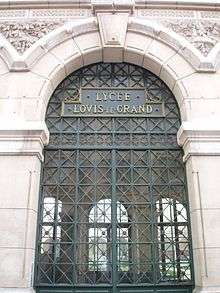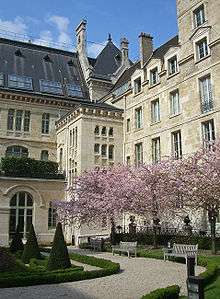Lycée Louis-le-Grand
| Lycée Louis le-Grand | |
|---|---|
 Front entrance of the Lycée Louis-le-Grand, in Paris, one of the most famous lycées providing preparatory classes for grandes écoles | |
| Address | |
|
123 rue Saint-Jacques Paris 75005 France | |
| Coordinates | 48°50′53″N 2°20′40″E / 48.848056°N 2.344528°E |
| Information | |
| Type | local public Institution (EPLE) |
| Established | 1 October 1563 |
| Headmaster |
Marcel Boureau [1] |
| Number of students | 1,818 students in 2009 |
| Medium of language | French |
| Language | German, English, Arabic, Chinese, Spanish, Ancient Greek, Hebrew, Latin, Russian, Vietnamese |
| Website |
www |

The Lycée Louis-le-Grand (French pronunciation: [lise lwi lə gʁɑ̃]) is a public secondary school located in Paris. Founded in 1563 as the Collège de Clermont, it was renamed in King Louis XIV of France's honor after he extended his direct patronage to it in 1682. It offers both a sixth-form college curriculum (as a lycée with 800 pupils), and a post-secondary-level curriculum (classes préparatoires with 900 students), preparing students for entrance to the elite Grandes Écoles (such as the École Normale Supérieure, the École Polytechnique, Centrale Paris, HEC Paris or ESSEC Business School). Students at the Lycée Louis-le-Grand are called magnoludoviciens.
Louis-le-Grand, founded in 1563, is located in the heart of the Quartier Latin, the traditional student's area of Paris. Rich in history, architecture, culture, this area is home to some of the oldest and most prestigious educational establishments in France including the Sorbonne and the Collège de France. The lycée is situated close to the place du Panthéon, which is the location of its historical rival, the Lycée Henri-IV. These two lycées are home to the oldest preparatory classes in France, which are commonly viewed as the most selective in the country.
Because of this, Louis-le-Grand is considered to play an important role in the education of French elites. Many of its former pupils have become statesmen, diplomats, prelates, marshals of France, members of the Académie française, and men and women of letters. "The Jesuit College of Paris", wrote Élie de Beaumont in 1862, "has for a long time been a state nursery, the most fertile in great men". Indeed, former students have included writers Molière, Voltaire, Victor Hugo and Charles Baudelaire, revolutionaries Maximilien Robespierre, Louis Antoine de Saint-Just, Marquis de Sade and Camille Desmoulins, former French presidents Raymond Poincaré, Paul Deschanel, Alexandre Millerand, Alain Poher, Georges Pompidou, Valéry Giscard d'Estaing and Jacques Chirac as well as many other ministers and prime ministers, philosophers such as Emile Durkheim, Denis Diderot, Jean-Paul Sartre and Jacques Derrida, scientists Évariste Galois, Henri Poincaré and Laurent Schwartz, and artists Eugène Delacroix, Edgar Degas and Georges Méliès. Renowned foreign students of the lycée include King Nicholas I of Montenegro, Léopold Sédar Senghor, and Saint Francis de Sales.
Admission to Louis-Le-Grand is very competitive; the strict selection process is based on academic grades, drawing from middle schools throughout France. The education is highly rated and the conditions of work are optimal due to the diverse qualities of the teachers.Louis-Le-Grand students generally achieve high marks and results for the baccalauréat, with a pass rate of 100% in most years, against a national pass rate of about 80%. The Concours général (national competition for brilliant students) and the examinations to enter the grandes écoles are considered more difficult. Overall,Louis-le-Grand provides a high level of education due to its rigorous selection process and the quality of its teachers.
Abu Dhabi Section
In September 2008, LLG and the Abu Dhabi Education Council launched the Advanced Math and Science Pilot Class. There is a class designed for girls (20 girls) and another for boys (20 boys). Classes will be taught by professors sent from France, exceptionally the classes are taught in English.
The students who make up the Advanced Math and Science Pilot Class graduate at the end of the 12th grade and are awarded with a certificate of academic recognition by LLG.[2]
Notable alumni
Writers, philosophers and social scientists
- Alexandre Adler
- Alain-Fournier
- Auguste Angellier
- Jean-Henri Azéma
- Souleymane Bachir Diagne
- Alain Badiou
- Charles Barbier de Meynard
- Maurice Bardèche
- Charles Baudelaire
- Émile Beaussire
- Joseph Bédier
- Frédéric Beigbeder
- Alain de Benoist
- Lucien Bianco
- Marc Bloch
- Robert Brasillach
- Ferdinand Brunetière
- Pierre Bourdieu
- Paul Bourget
- Eugène Burnouf
- Michel Butor
- Laurent-Emmanuel Calvet
- Aimé Césaire
- Georges Chapouthier
- Patrice Chéreau
- Pierre-Robert de Cideville
- René Clair
- Paul Claudel
- Michel Cournot
- Jean-Loup Dabadie
- Léon Daudet
- Régis Debray
- Jacques Derrida
- Jérôme Deschamps
- Denis Diderot
- Maurice Druon
- Georges Dumézil
- Émile Durkheim
- Claude Esteban
- Octave Feuillet
- Maurice de Gandillac
- Théophile Gautier
- Georges Goyau
- Jean Guéhenno
- Paul Guth
- Louis Hachette
- Claude Hagège
- Jean-Barthélemy Hauréau
- Victor Hugo
- Joseph Kessel
- Henri Laoust
- Valery Larbaud
- Lefranc de Pompignan
- Bernard-Henri Lévy
- Émile Littré
- Jean-François Lyotard
- Quentin Meillassoux
- Robert Merle
- Maurice Merleau-Ponty
- Molière
- Charles Péguy
- Bertrand Poirot-Delpech
- Cardinal de Retz
- Claude Ribbe
- Olivier Rolin
- Jacqueline de Romilly
- Romain Rolland
- Marquis de Sade
- Philippe-Joseph Salazar
- Jean de Santeul
- Léopold Sédar Senghor
- Jean-Paul Sartre
- Pierre-Henri Simon
- Joseph Vendryes
- Jean Wahl
- Voltaire
Artists and composers
Scientists
- Henri Becquerel
- Jean Becquerel
- Eugène Belgrand
- Jean Bernard
- Irénée-Jules Bienaymé
- Alfred Binet
- Jean-Baptiste Biot
- Jean Cavaillès
- Michel Chasles
- Yves Colin de Verdière
- Émile Desvaux
- Évariste Galois
- Eugène Goblet d'Alviella
- Jacques Hadamard
- Félix d'Hérelle
- Charles Hermite
- Laurent Lafforgue
- Gabriel Lamé
- Louis Leprince-Ringuet
- Pierre-Louis Lions
- Arthur Morin
- Paul Painlevé
- Charles Pellat
- Gilles Pisier
- Henri Poincaré
- Laurent Schwartz
- Jean-Claude Sikorav
- Cédric Villani
- Étienne Wolff
- Jean-Christophe Yoccoz
Statesmen and politicians
- Paul Biya, second President of Cameroon
- Jacques Chirac, 22nd President of the French Republic
- Michel Debré, first Prime Minister of France
- Božidar Đelić, Vice-President of Serbia
- Paul Deschanel, 11th President of the French Republic
- Laurent Fabius, 9th Prime Minister of France
- Valéry Giscard d'Estaing, 20th President of the French Republic
- Jean Jaurès, first president of the French Socialist Party
- Alain Juppé, 15th Prime Minister of France
- Pierre Mendès France, 126th President of the Council of Ministers of France
- Pierre Messmer, 5th Prime Minister of France
- Alexandre Millerand, 12th President of the French Republic
- Milan I of Serbia, King of Serbia
- Nicholas I of Montenegro, 1st King of Montenegro
- François Joachim de Pierre de Bernis, French cardinal and statesman
- Alain Poher, interim President of the French Republic
- Raymond Poincaré, 10th President of the French Republic
- Georges Pompidou, 19th President of the French Republic
- Michel Rocard, 11th Prime Minister of France
- Léopold Sédar Senghor, first President of Senegal
- Maximilien de Robespierre, French revolutionary
- Louis Antoine de Saint-Just, French revolutionary
- Camille Desmoulins, French revolutionary
Other personalities
During World War II, student Jacques Lusseyran founded the resistance group Volontaires de la Liberté.[4]
Courtyards
There are several courtyards at the school:
 Cour Victor Hugo
Cour Victor Hugo.jpg) Cour Victor Hugo
Cour Victor Hugo Cour Molière
Cour Molière Cour d'Honneur
Cour d'Honneur
See also
References
- ↑ « Du lycée Montaigne à Louis-le-Grand », Sud-Ouest, May 8th, 2012.
- ↑ http://llgparis-abudhabi.org/images/PDF/Project_presentation.pdf
- ↑ Historique du lycée par Paul Deheuvels, proviseur de 1969 à 1991. Consulté le 30 mars 2008.
- 1 2 Hochard, Cécile. "Journal des Volontaires de la Liberté: Le Tigre". Musée de la Résistance et de la Déportation à Besançon. Retrieved 10 March 2014.
External links
| Wikimedia Commons has media related to Lycée Louis-le-Grand. |
(These pages are in French)
- http://www.louis-le-grand.org/albedo/index.php (official)
- http://fcpe.llg.free.fr/ (parents' association)
- http://peepllg.com (parents' association)
- https://www.louislegrand.net (online directory for student, alumni and teacher)